Physical Address
304 North Cardinal St.
Dorchester Center, MA 02124
The adnexa are composed of the ovaries, fallopian tubes, blood vessels, and supporting tissues such as the broad ligaments. The ovaries are a key component of the pelvic ultrasound examination, but it is also important to assess the surrounding tissues. The broad ligaments and fallopian tubes are not routinely identified sonographically unless they are thickened, dilated, or surrounded by fluid.
The ovaries are ovoid or teardrop in configuration and elongated in contour. Follicles are depicted as rounded, thin-walled anechoic cystic structures in the ovary ( Fig. 24-1 ). Identification of follicles distinguishes the ovary from adjacent structures such as bowel loops and uterine masses. The ovaries are typically positioned lateral to the uterus and anteromedial to the internal iliac blood vessels ( Fig. 24-2A and B ). Less frequently they are found posterior to the uterus in the cul-de-sac, or superior to the uterus (see Fig. 24-2C and D ). Occasionally an ovary is situated anterior to the uterus, interposed between the uterus and the anterior abdominal wall. A cystic ovarian mass in this location can resemble the urinary bladder (see Fig. 24-2E ). When the uterus is enlarged (e.g., by pregnancy or fibroids), the ovaries may be displaced superiorly and laterally (see Fig. 24-2F ). Following hysterectomy, the ovaries frequently assume a medial and caudal position near the vaginal cuff. Ovarian volume can be estimated by multiplying length × width × depth and dividing by 2 (a simplified version of the formula for the volume of an ellipse).
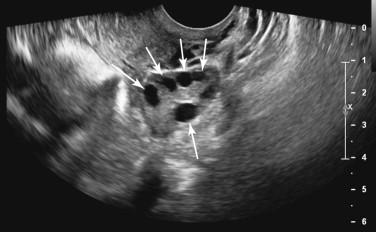
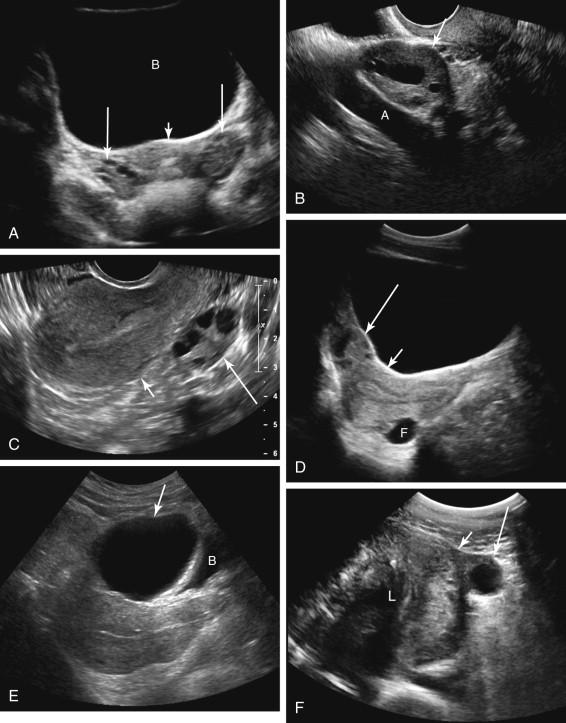
The ovaries evolve in size and appearance over time. They are larger during the neonatal period than later in infancy because follicle-stimulating hormone (FSH) levels increase following separation of the placenta from the fetus and later decline. Follicles are frequently seen in neonates. Ovarian volume measures up to 3.6 cc in the neonatal period and gradually decreases over the next 2 years, exhibiting a mean volume of 1 to 2 cc from approximately 2 to 8 years of age. Follicles are also commonly visualized in children in the 2- to 8-year-old age group, although they tend to be smaller than during the neonatal period ( Fig. 24-3 ). The ovaries begin enlarging by about 8 years of age, increasing in size as puberty approaches, and continue to grow for several years following puberty.

The ovaries exhibit cyclical changes over the course of the menstrual cycle in women of reproductive age. Follicles are smallest during the early proliferative phase of the cycle when they are typically several millimeters in size or less ( Fig. 24-4A ). One or more follicles begin enlarging as the proliferative phase progresses, often reaching 1 to 1.5 cm in diameter (see Fig. 24-4B ). A dominant follicle becomes apparent before ovulation, growing more rapidly than the other follicles. By the time of ovulation the dominant follicle can measure almost 3 cm (see Fig. 24-4C ). The remaining follicles typically remain small or regress. Two dominant follicles develop in a minority of menstrual cycles, and therefore it is not uncommon to visualize two or more prominent follicles in a normal ovary. In addition, nondominant follicles occasionally attain a size similar to that of the dominant follicle.
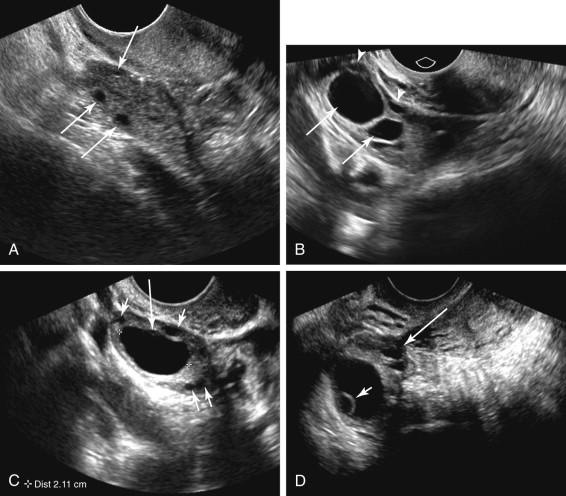
The dominant follicle contains an oocyte surrounded by a cluster of cells termed the cumulus oophorus. Ultrasound depicts the cumulus oophorus as a small curvilinear or cystic structure along the inner margin of the dominant follicle, sometimes resulting in a cyst-within-a-cyst appearance (see Fig. 24-4D ). At the time of ovulation, the dominant follicle ruptures and the oocyte is released. The fluid in the ruptured follicle escapes, often resulting in a small amount of free fluid in the pelvis. The ruptured follicle transforms into a corpus luteum, which secretes progesterone and small amounts of estrogen to support the endometrium during the secretory stage of the menstrual cycle. Ultrasound depicts the corpus luteum as a rounded structure with a thick wall, an irregular crenulated hypoechoic inner surface, and a peripheral rim of blood flow without central vascularity ( Fig. 24-5A and B ). Identification of an ovarian structure with this characteristic appearance is consistent with a normal corpus luteum and should not be misinterpreted as an abnormal mass. Sometimes the corpus luteum has a prominent central fluid area resulting in the appearance of a cyst (see Fig. 24-5C ). The corpus luteum is usually less than 3 cm in diameter, although occasionally it is larger, particularly when the cystic component predominates (see Fig. 24-5D ). A hemorrhagic cyst forms if the corpus luteum bleeds internally and re-expands (see Fig. 24-5E ). If a pregnancy does not develop, the corpus luteum stops secreting hormones and regresses after approximately 14 days, menstruation begins, and the cycle starts again.
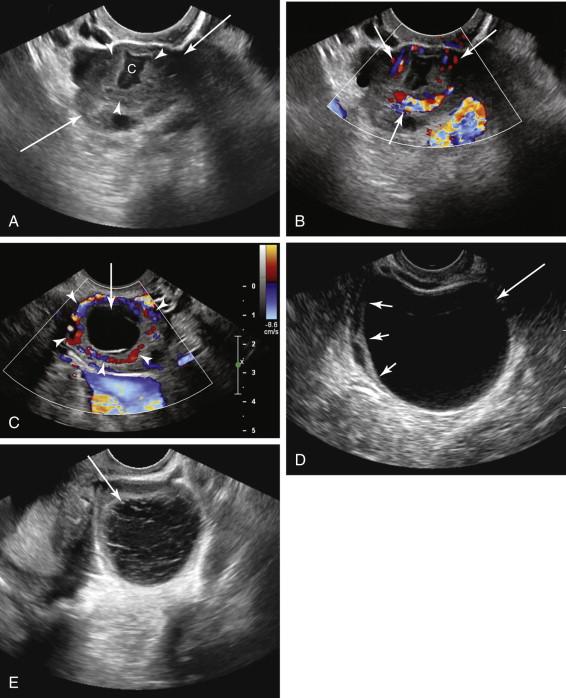
The postmenopausal period begins 1 year after complete cessation of menses. Folliculogenesis stops, the remaining follicles atrophy, and the ovaries progressively decrease in size. The postmenopausal ovary is often difficult to visualize due to its small size and absence of follicles, particularly in elderly women ( Fig. 24-6A ). Care should be taken to distinguish bowel from the ovary by searching for peristalsis and the serpiginous interconnecting configuration of bowel loops. Identification of a hypoechoic rim around the periphery of the postmenopausal ovary due to tiny residua of follicles is helpful in identifying the ovary, and is more commonly seen during the early postmenopausal years (see Fig. 24-6B ). The size of a postmenopausal ovary depends on the time since menopause. Normal postmenopausal ovarian volumes typically range between 1 and 6 cc. A volume larger than 8 cc is abnormally large. In addition, ovarian volume larger than two times the size of the contralateral ovary is considered abnormally large, even if both ovaries are otherwise within normal limits in size.
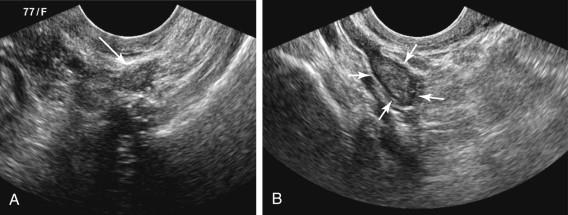
Ultrasound frequently reveals tiny punctate echogenic foci in otherwise normal-appearing ovaries during the reproductive and postmenopausal years ( Fig. 24-7A ). Sometimes these foci exhibit posterior comet-tail artifact (see Fig. 24-7B ). Although the etiology of the foci is not clear, they are not thought to be clinically important. Proposed etiologies include tiny calcifications, hemosiderin deposits, or specular reflectors from the walls of tiny nonvisualized cysts. Similar echogenic foci are seen in the wall of some endometriomas, but in the absence of an ovarian mass suggestive of an endometrioma, punctate echogenic foci are not considered a sign of endometriosis. Punctate echogenic ovarian foci can be helpful in confirming the ovary has been identified, particularly when other identifying landmarks such as follicles are not visible during the postmenopausal period (see Fig. 24-7C ).
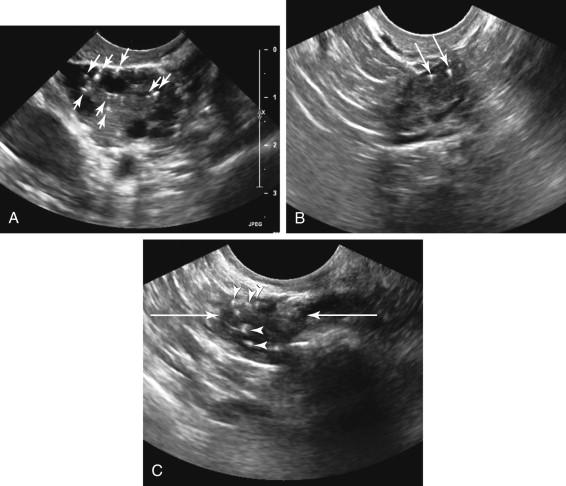
Ultrasound frequently depicts cystic structures such as follicles and corpus luteal cysts in normal ovaries. Follow-up of all ovarian cysts would engender unnecessary cost and patient anxiety. A statement from a consensus conference sponsored by the Society of Radiologists in Ultrasound (SRU) and published in 2010 offers guidance regarding management of adnexal lesions identified in asymptomatic patients. Unless otherwise noted, references to a consensus conference in this chapter refer to this SRU Consensus Conference.
The dominant follicle can measure almost 3 cm, so the consensus statement specifies that a simple ovarian cyst measuring up to 3 cm is a normal physiologic finding in a woman of reproductive age. In postmenopausal women, although normally recurring cycles of folliculogenesis do not occur, small subcentimeter simple cysts are frequently observed ( Fig. 24-8A ). These cysts are more commonly visualized during the first 5 years after the final menstrual period (termed early postmenopause ) when an occasional ovulatory cycle is possible, but also can be identified subsequently ( late postmenopause ). Consequently, a simple subcentimeter ovarian cyst in a postmenopausal woman is not considered clinically important and no follow-up is recommended.
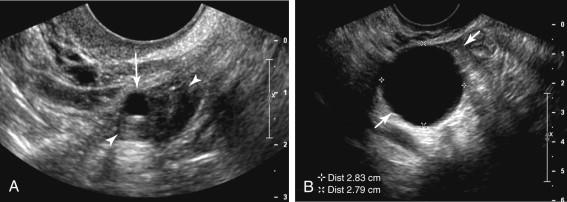
The consensus conference recommendation for simple cysts larger than 3 cm in women of reproductive age and larger than 1 cm postmenopause is based on the premise that a simple adnexal cyst is very likely to be benign provided the entire cyst can be imaged adequately to characterize it as entirely simple. A cyst is considered simple if it is anechoic with a thin or imperceptible wall, without wall thickening, nodules, or internal echoes and exhibits posterior enhancement. In postmenopausal women annual follow-up is recommended for simple cysts larger than 1 cm and smaller than or equal to 7 cm (see Fig. 24-8B ). In women of reproductive age, simple ovarian cysts smaller than 3 cm are considered a normal finding ( Fig. 24-9A ). No follow-up is recommended for a simple cyst larger than 3 cm and smaller than or equal to 5 cm, although the consensus statement recommends that the cyst be described in the report (see Fig. 24-9B ). Annual follow-up is recommended for simple cysts larger than 5 cm and smaller than or equal to 7 cm in the reproductive age group (see Fig. 24-9C ). Because cysts measuring larger than 7 cm may be too large to image the entire cyst wall with ultrasound, further assessment with pelvic magnetic resonance imaging (MRI) or surgical evaluation is recommended for these cysts in both the reproductive age and postmenopausal groups (see Fig. 24-9D ). Many of these larger simple ovarian cysts correspond to follicular cysts or serous cystadenomas. A follicular cyst forms when the dominant follicle does not ovulate and instead continues to enlarge during the next menstrual cycle, often growing considerably larger than 3 cm. The term follicular cyst should not be used to describe a normal follicle.
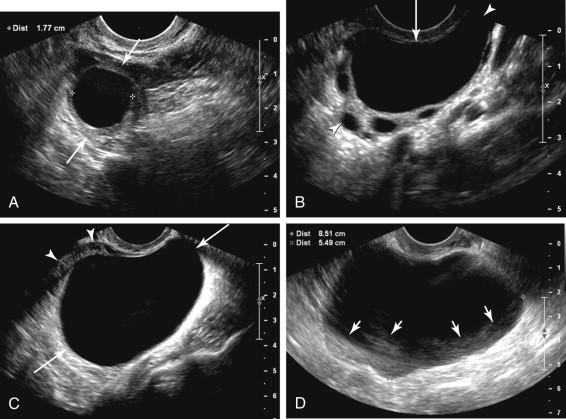
Become a Clinical Tree membership for Full access and enjoy Unlimited articles
If you are a member. Log in here